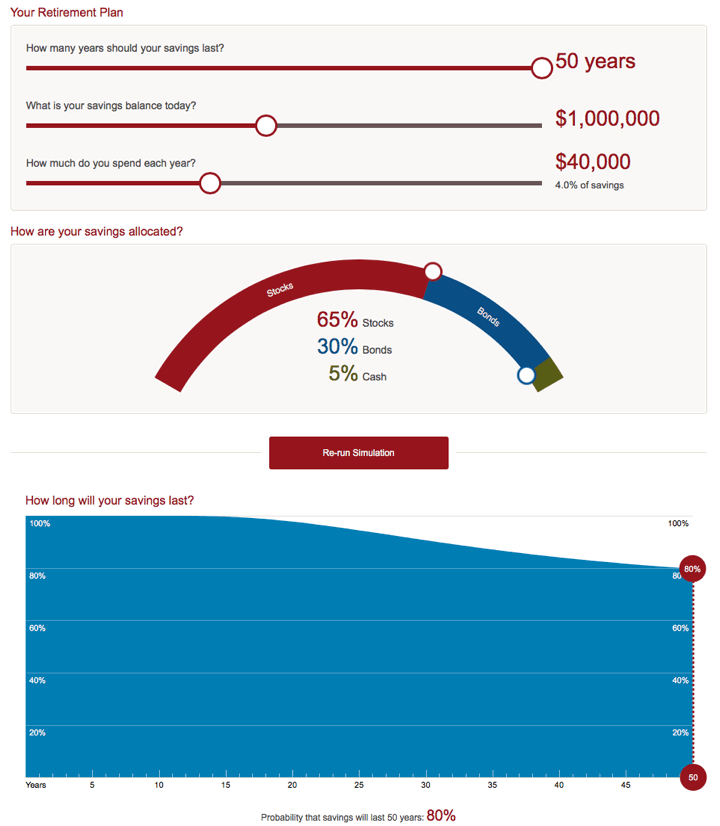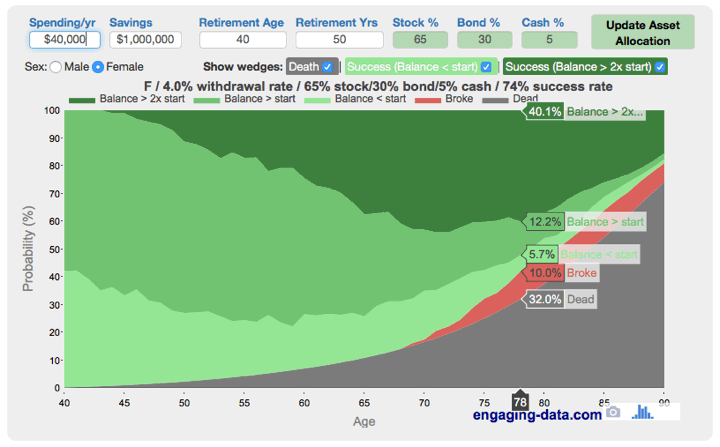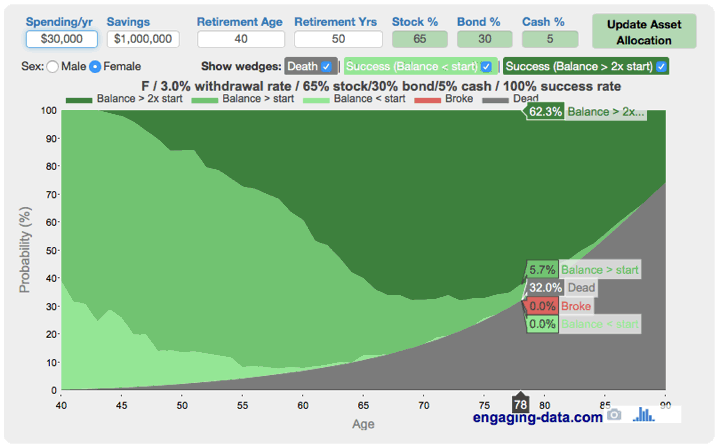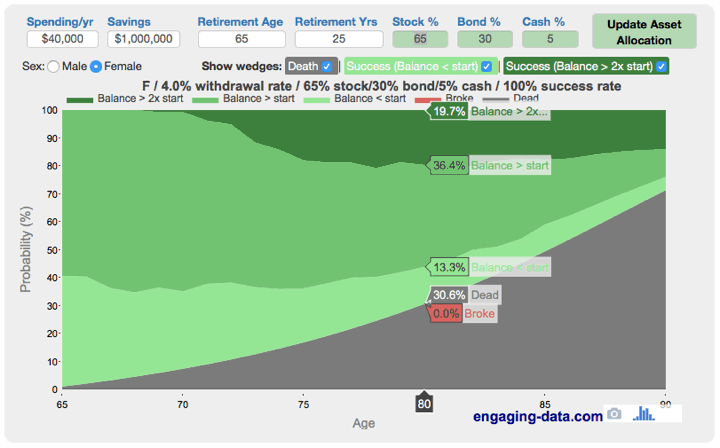 If you have researched retirement at all (early or otherwise), you’ve probably ran across various retirement calculators online. You input how much money you have (or plan to have), your asset allocation, and it spits out some numbers. This Vanguard Retirement Nest Egg Calculator is a good example of a simple version.
If you have researched retirement at all (early or otherwise), you’ve probably ran across various retirement calculators online. You input how much money you have (or plan to have), your asset allocation, and it spits out some numbers. This Vanguard Retirement Nest Egg Calculator is a good example of a simple version.
Let’s try an example. If I am 40 years old and thus assume I have up to 50 years left in retirement, and I want to maintain a 4% withdrawal rate ($40,000 a year from a $1,000,000 portfolio that is 65% stocks/30% bonds/5% cash), the tool uses Monte Carlo simulations to calculate that I have an 80% chance of lasting 50 years.

There is effectively one output: the odds of not running out of money. Either you still have at least a dollar, or you don’t. In my example, I have an 80% chance of having $1 or more at age 90.
But what if you also considered the odds of running out of time? Yes, that’s a euphemism for dying. (Ever notice how many of those we have?) In another neat tool from Engaging-Data.com, Will Your Money Last If You Retire Early? adds some helpful nuance to this analysis. You input the same types of information, but now in any given year you are provided the overall odds of each of these things happening:
- Red – You are alive, but ran out of money.
- Light green – You are alive, with less money than you started with. (Kinda nervous?)
- Green – You are alive, with between 100% and 200% of what you started with. (Nice and comfy.)
- Dark green – You are alive, with over 200% of what you started with. (In hindsight, I didn’t need to save so much…)
- Grey – You are pushing up daisies. (In hindsight, maybe should’ve retired earlier…)
Here are sample results for the early retirement scenario above at 4% withdrawal rate (age 40, retirement horizon 50 years, $40k from a $1m 65/35/5 portfolio). I picked the female mortality table – if you have a male/female couple, it’s safer to pick the person likely to live longer.

There’s an angry streak of red where I’m broke. Of course, there’s a bigger streak of grey where I’m not breathing.
Here’s the same scenario, except with a lower 3% withdrawal rate ($30,000 a year from a $1,000,000 initial portfolio):

That change got rid of the red, but there is a lot of dark green. (1% makes a big difference.)
Here are sample results for a more traditional retirement scenario: (age 65, retirement horizon 25 years, $40k from a $1m 65/35/5 portfolio)

As a financially conservative person, these charts help illustrate why I prefer working with a 3% safe withdrawal rate for early retirement (50 and under) and 4% safe withdrawal rate for traditional retirement (closer to 65).
My favorite part of this tool is that it makes you take into account your mortality. It’s not all about staying above $1 in the bank, but also about maximizing your years of freedom. If you’re 40, you have a 10% chance of dying before even reaching 65. (This is why most people know someone who died shortly after retirement.) Is it better to have zero chance of broke and be 70, or 5% chance of broke and 60 with 10 more years of retirement (and 10 fewer years of work)? It is better to live a little more luxuriously for shorter time, or a little more frugally for a longer time? Playing around with all the different input variables might help you weigh the options.
 The Best Credit Card Bonus Offers – 2025
The Best Credit Card Bonus Offers – 2025 Big List of Free Stocks from Brokerage Apps
Big List of Free Stocks from Brokerage Apps Best Interest Rates on Cash - 2025
Best Interest Rates on Cash - 2025 Free Credit Scores x 3 + Free Credit Monitoring
Free Credit Scores x 3 + Free Credit Monitoring Best No Fee 0% APR Balance Transfer Offers
Best No Fee 0% APR Balance Transfer Offers Little-Known Cellular Data Plans That Can Save Big Money
Little-Known Cellular Data Plans That Can Save Big Money How To Haggle Your Cable or Direct TV Bill
How To Haggle Your Cable or Direct TV Bill Big List of Free Consumer Data Reports (Credit, Rent, Work)
Big List of Free Consumer Data Reports (Credit, Rent, Work)
Interesting tool, and morbidly “fun” to use. I think you have your light green and dark green definitions switched.
Thanks, fixed!
Hi just a point that the color descriptions (eg. dark green) are backwards… also typo: arte 😉
Thanks, fixed!
Why would you post this first when I already told him after you did?
I did it because I could. It’s this talent that makes me such a good investor.
Interesting. As an investor who is closer to retirement than you, I am wondering if you have considered the impact of mandatory distributions. I am 59 1/2 and know that I will need to take those mandatory withdrawals at age 70; however, I will be forced by to take out more money than I predict I will need and I don’t really like the idea of having dictated withdrawals from those tax-deferred accounts. I’m interested in leaving some money to my (grateful?) heirs.
Have you considered taking advantage of Roth conversions?
I am not familiar with Roth conversions and will look into it. My (uneducated) impression was that one could either contribute to a Roth or do a conversion, holding to the $6,500 yearly limit. Any brief synopsis of pros and cons to recommend?
I don’t have anything especially clever to say about RMDs… That’s kind of the reason they created RMDs, to make you pay some tax eventually. Otherwise, it’s not taxed on the way in, and it’s not taxed on the way out.
As Aaron suggests, perhaps you can minimize the tax by taking a Roth conversion when your tax rate is lower.
Jonathan! For a long time I made the assumption that when one retires one’s tax rate will be lower, but as a lifelong 403(b) saver who takes advantage of tax-deferred savings and as small-business owner with high overhead, my tax rate hovers at 12% right now. I think my tax rate might actually increase when I begin withdrawing from 403(b) and taking S.S. as I have no way to “shelter” that income from taxes.
These calculators are well and good as long as your life runs relatively predictably. But they don’t take into account unexpected large expenses like dental work, medical expenses, accidents, assisted living, etc, etc, etc.
I was just thinking about how the use of decimal points in such long-term planning is rather silly. I do it myself, of course.
No calculator is going to accurately predict your future, and it would be silly to expect one to do so. When you use any tool, you need to understand its limitations. This calculator is probabilistic, but not prognostic. Still, it can give you an idea based on its inherent assumptions if you will meet your retirement goals.
When you switch to 3% withdrawal rate, you’re saying “BUT” there’s a lot of dark green. That “BUT” is confusing. Dark green actually is the best scenario. You get rid of probability of going broke AND you increase the probability of increasing where you started over 2 times.
Also I’m not clear on the chances of being dead. On the graph it doesn’t change between 4% and 3% withdrawal rates. Maybe that is correct as in both cases it seems that you have enough money to buy all necessary medical care. But in general there’s correlation between wealth and longevity so as you get more money, the grey part should be shrinking a bit, as long as you’re smart enough to invest more in preventive medicine.
What I totally don’t get is why someone who retires at 40 has 32% chance of being dead by 78 but someone who retired at 65 with the same money has 30.6% chance of being dead by 80. Working longer prolongs life? 😉
About the probabilities: my best guess is that the numbers are being run *after assuming that you make it to retirement age in the first place*. So, if you survive to 40, then you still have a 68% chance of surviving to 78. But, if you further survive to 65, then you have a 69.4% chance of surviving to 80. So, the percentages reflect the survivorship bias of a shrinking pool of people still alive at each higher age. You can input an age of 1 to see that a 1-year old female has only a 61.4% chance of making it to 80. Surviving each additional year improves your odds of making to 80; if you make to 80, then you have a 100% chance of being alive 😉
I don’t think these numbers make any assumptions about the complexities of how wealth impacts health; they are just average data from US SSA.
The goodness of any scenario is subjective. Some could view having too much dark green as a negative because it means that they’ve worked longer than necessary. On the other hand, if you plan to leave an inheritance or legacy, having a lot of dark green would be a positive. It really depends on your situation and goals.
The chance of being dead comes from the selected mortality table and your current age. It has nothing to do with the withdrawal rate.
You’re comparing different things here. The age attained makes a difference. In the first case, the person is currently 40 years old and has a 32% chance of being dead by the age of 78. In the second case, the person is currently age 65 and has a 30.6% chance of being dead by 80. Each additional year you live changes the probabilities in the future.
I understand your point, and you are right of course that having a lot of money is good. I add the “but” because Dark Green could also be taken as “I could have retired earlier, or spent more money in earlier years”. Try a 0.5% withdrawal rate and you’ll get a lot of dark green, but that doesn’t necessarily make it the optimal plan.
As to your last point, it has to do with age cohorts. If you are alive at 65, you are part of a cohort/group that will live longer than someone who is in the age 40 cohort/group. (The people who died between 40 and 65 are no longer in the age 65 cohort.) Simply being older means your specific life expectancy increases.
plugged in my numbers and gulp…not looking good haha.
more working years at my desk (sigh), and hopefully Social Security will still be solvent when i retire. in the meantime, more saving to do!
What I find fascinating is that the longer the retirement, the more binary it becomes. If you forget about death for a moment (uncheck the death box) and you just look at your portfolio, you either become very rich or very broke given enough time. Using historical data, a 70-year retirement gives less than 10% chance of being in the middle and it doesn’t seem to matter what numbers you plug in. Granted, there aren’t very many 70 year periods that we can look at, but I bet a Monte Carlo calculator will give us the same result.
The point I bring up might elicit a “well, duh” response from the more mathematically/logically minded, but it is interesting to consider that if we live long enough we are going to find out whether we hit the lottery or whether we were destined to go bust. Of course, you can increase your odds of the former with lower withdrawal rates and heavier stock allocations, but given enough time, it will be one or the other.
Having said all that, this is really just a thought experiment. Few of us are going to sit around and watch their portfolios dwindle to nothing, especially over such a long time horizon. If it looked like we might be heading for broke, almost all of us readers here would get off our tail and start looking for a side hustle if we hadn’t already found one!
I am curious how does this factor in advancements in the future. Eg: If Elon Musk has some revolutionary idea to double your life span but it costs $2M would it be worthwhile working extra to save that extra $1M?
Interesting, since Musk is having a hard enough time being a CEO and getting model 3s out. I’d temper that idea of him coming up with a double life span cure and if he does if he ever releases it before everyone dies.